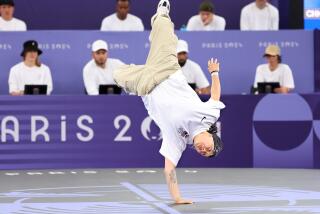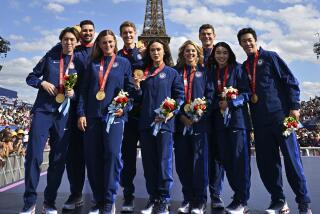Glitch May Be Skaters
- Share via
TURIN, Italy — The winner landed five triple jumps and no triple-triple combination.
The silver medalist fell on her first jump and was so off-balance on her second that she instinctively touched her hands to the ice to keep from tumbling.
The bronze medalist fell once and was so panicky that she began improvising. She turned her fourth jump into a double-double combination, a good strategy -- if she’d been competing at a junior event.
It wasn’t such a great idea during the long program at the Olympics.
An asterisk should be appended to the results of the first women’s Olympic competition decided by figure skating’s new judging system. Many performances in Thursday’s finale were badly flawed and none of the leaders matched the difficult jumps done by the top female skaters at Nagano in 1998 and Salt Lake City in 2002.
In winning the gold medal at Nagano, Tara Lipinski landed seven triple jumps, two in combination. Silver medalist Michelle Kwan also landed seven. At Salt Lake City, Sarah Hughes landed two difficult triple-triple combinations and seven triple jumps overall in zooming from fourth after the short program to first.
No one approached that level of technical mastery in Thursday’s long program.
Sasha Cohen, who fell on a triple lutz and put her hands down on a triple flip, called her silver medal a gift. She was so sure she’d drop out of the top three that she took off her competition dress and changed into street clothes before the results were announced. When she learned she’d finished second, she told her coach, John Nicks, that she’d been lucky.
He agreed.
“Usually, the Olympics is a bit stronger competition,” Cohen said Friday.
She couldn’t pinpoint why the women’s event was such a scramble this time.
“I don’t know,” she said. “It was just an odd year.”
Shizuka Arakawa, the first Japanese figure skater to win an Olympic title, landed five triple jumps, none in combination. Cohen, of Corona del Mar, landed five triples, also without a triple-triple. Third-place finisher Irina Slutskaya of Russia, the reigning world champion, landed only four clean triples after she’d fallen once and downgraded a planned triple-double to a double-double.
“I think it was obvious that the standard of skating wasn’t particularly good,” said Nicks, a veteran of two Olympics as a pairs skater and 11 as a coach.
“The new system is so demanding and so difficult. I’ve taught for 35 years and the last two years I’ve had to redo my philosophy.”
Spins that once consumed 30 seconds of a program now eat up a minute, leaving skaters less time in which to cram jumps, footwork and other moves that pile up points. Singles skaters must do three spins in their short programs and four in what the International Skating Union calls a well-balanced free skate.
Ottavio Cinquanta, president of the ISU and the chief advocate for reform after a judging scandal erupted at Salt Lake City, said the new system’s Olympic debut was “more than a success, it was a triumph.”
“This doesn’t mean the system is perfect,” he said. “Nothing is perfect. But we are very, very satisfied.”
He added that the reason for the decline in quality in the women’s final “is clear,” assigning blame to national skating federations for not developing skaters who will thrive under the new rules.
“The ISU can produce administration, a system of judging, can organize competitions, but we don’t produce the skaters,” he said during Friday’s exhibition gala at the Palavela. “So if the member federations, the national federations, they are unable to make available talent, it is not the fault of the ISU....
“As a general consideration today, the programs of the skaters in figure skating today are much, much more difficult than before, and in the past, in general. But I repeat, to not have the talent is another story.”
Cinquanta also said he considered Arakawa’s gold medal a milestone and praised Japanese skating officials for adapting to the new system.
“The result of the Japanese skaters, especially the women, in the last two seasons, it is evident it is very strong,” he said. “This is the merit of the federation.”
He says he sees no need to change the judging system now but expects it to evolve.
“Maybe for 10 years you maintain a certain scale of points, and after 10 years you change because the way of skating or the skater has changed,” he said. “And this is not dependent upon the system.”
After winning one gold medal and two bronze medals at Salt Lake City, U.S. figure skaters won two medals here, both silver. Before Cohen’s runner-up finish, ice dancers Tanith Belbin and Ben Agosto became the first U.S. skaters to win a medal in that discipline since 1976.
David Raith, executive director of U.S. Figure Skating, said the two medals were “something that we look forward to building upon.... The coming seasons look strong with so many Olympic team members planning to return, and they’ll be contending with a sizable group of promising, young up-and-comers.”
Cohen is among those planning to return. She said Friday she plans to compete at the world championships next month in Calgary, Canada, and would remember not that she fell early in her program here, but that she finished strong.
“I worked really hard here and had fun with the process,” she said. “It’s bittersweet, but I walk away with no regrets.”
More to Read
Go beyond the scoreboard
Get the latest on L.A.'s teams in the daily Sports Report newsletter.
You may occasionally receive promotional content from the Los Angeles Times.








